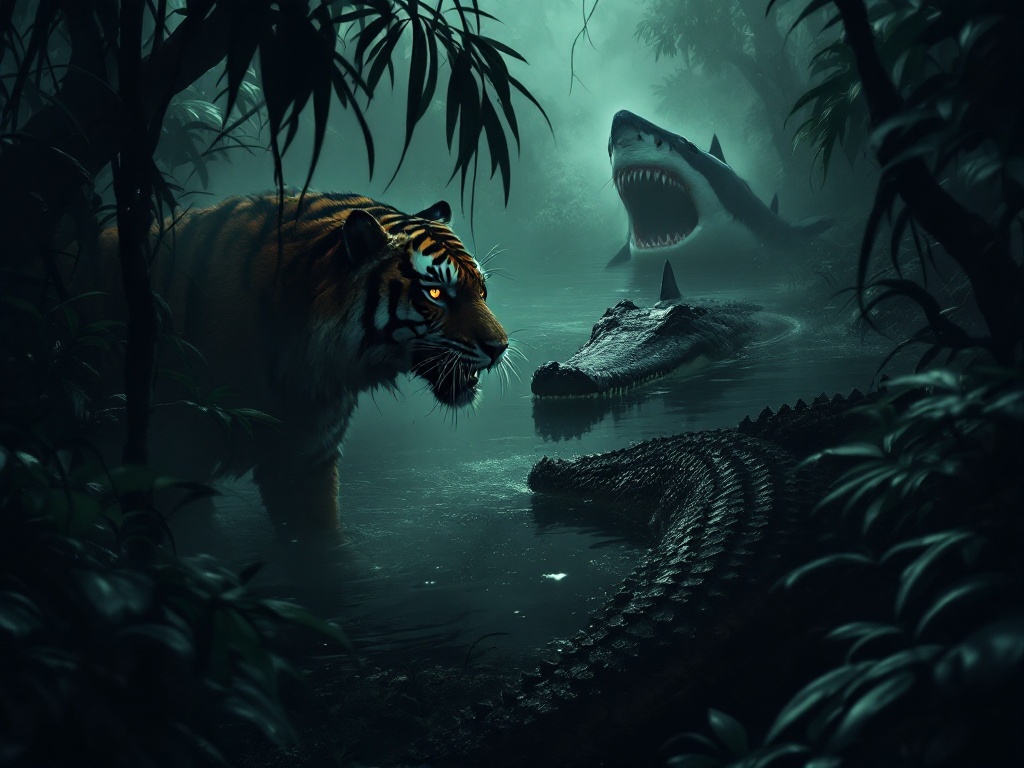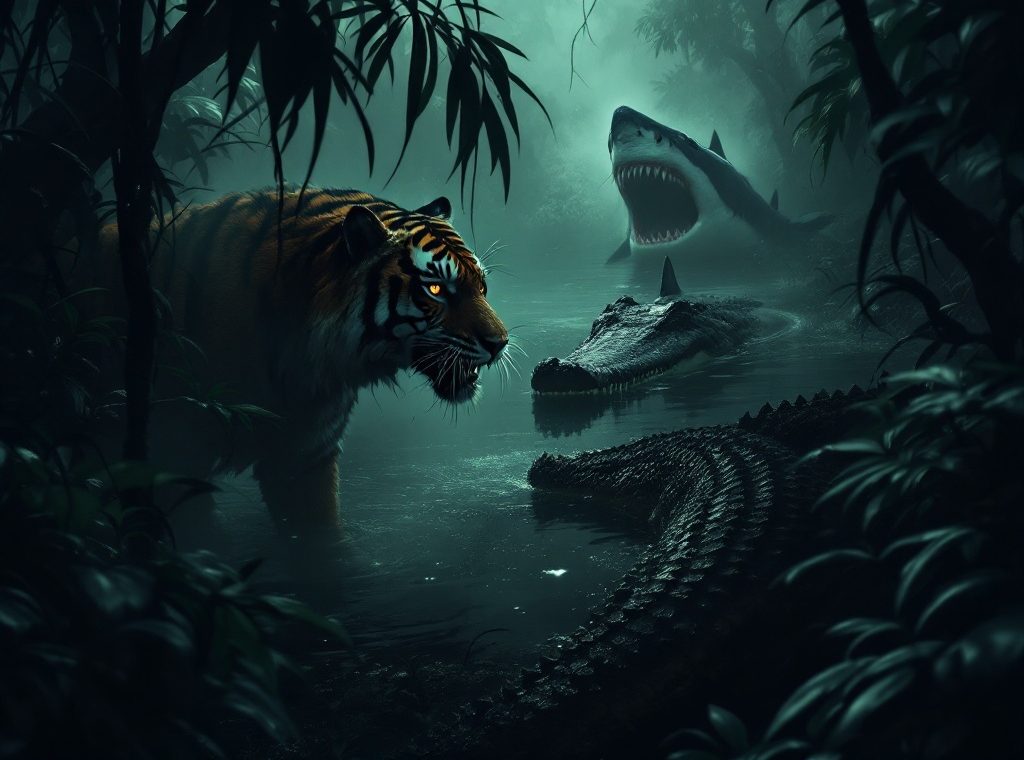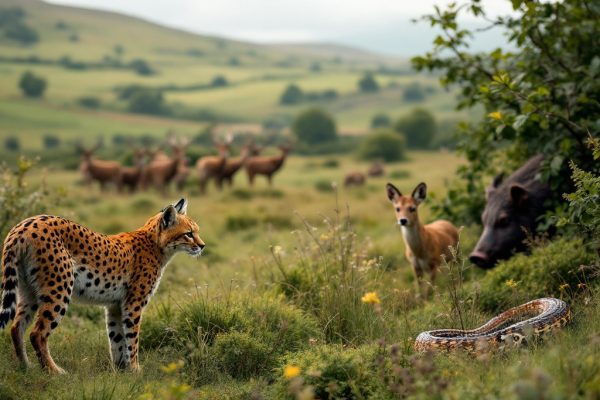What Animals Can Eat Humans: Watch Out
Dive into the chilling world of man-eaters, where predators like saltwater crocodiles, great white sharks, and Bengal tigers hunt humans. Discover the factors driving these apex predators, from starvation and old age to a developed taste for human flesh. Explore the dangers posed by tigers in the Sundarbans, lions in Tanzania, and the rare but terrifying attacks by Komodo dragons and reticulated pythons. Learn how even leopards and hyenas can become a threat to humans. Uncover the historical accounts of man-eaters and understand the risks associated with these powerful creatures. Continue reading to explore this fascinating yet dangerous side of the animal kingdom.
Important information

- Tigers are considered the most dangerous man-eaters among big cats, having caused more human deaths than any other feline.
- Saltwater crocodiles attack humans more frequently than other crocodile species, posing a significant threat.
- Lions kill an estimated 20 to 250 people yearly, driven by factors like hunger or old age.
- Reticulated pythons are known to kill humans by constriction and are capable of swallowing them whole.
- While several animals can and do attack humans, humans are not their typical prey. Factors like starvation, injury, or illness can lead to these attacks.
Introduction to Human-Eating Animals
Some predators, known as “man-eaters,” actively hunt humans for food, making human flesh part of their diet. This behavior is different from scavenging or self-defense. Saltwater crocodiles, great white sharks, African lions, Bengal tigers, spotted hyenas, and Komodo dragons are known man-eaters. However, humans are not the usual prey for these apex predators. Several factors can lead an animal to become a man-eater.
- starvation,
- old age,
- injury,
- illness,
- developing a taste for human flesh after an initial encounter.
While domestic dogs may attack humans, they are not typically considered man-eaters like their wild counterparts. However, packs of stray dogs have been known to cause fatalities. Wolves, generally smaller than many apex predators, are less of a threat, with attacks mainly targeting children in areas where wolves have become used to humans. It is important to note that parasites, unlike predators, target specific parts of the human body for sustenance.
Land Predators That Can Eat Humans
Tigers are notorious as the most dangerous man-eaters.
Lions, particularly those injured or elderly, also pose a threat to humans.
Nocturnal leopards can develop a taste for human flesh.
Hyenas, hunting in packs, are another significant danger, capable of easily killing a person. Though Komodo dragon attacks are rare, their venomous bite presents a serious risk.
Tigers: The Most Notorious Man-Eater
Tigers are the most dangerous big cats to humans, responsible for more human fatalities than any other feline species. For instance, in the Sundarbans, these apex predators killed 129 people between 1969 and 1971, a stark illustration of their deadly power.
Lions: Quick to Prey on Humans
Lions, as apex predators, hunt large animals, including humans. Research indicates they kill between 20 and 250 people annually. In Tanzania alone, 593 lives were lost to lion attacks between 1990 and 2004. The infamous Tsavo man-eaters killed approximately 130 railway workers in Kenya in 1898. Studies suggest these attacks may be driven by hunger or old age, rather than a survival instinct.
Leopards: Nocturnal Human Attackers
Leopards, primarily nocturnal hunters, occasionally attack humans, typically under the cover of darkness. In certain instances, after consuming human remains, these big cats develop a preference for human flesh, sometimes even venturing into human dwellings.
Hyenas: Capable of Killing an Adult Human
Hyenas, especially spotted hyenas, are dangerous to humans. Their powerful bite and pack hunting strategies make them a serious threat.
These opportunistic carnivores often target vulnerable people, particularly children and the infirm. However, even healthy adults can be attacked by hyenas under specific circumstances.
Komodo Dragons: Rare Human Predators
Komodo dragons are formidable reptiles that pose a significant threat to humans. Their impressive size and strength lead them to view humans as potential prey. Though attacks are infrequent, their sharp teeth, venomous saliva, and predatory nature make them dangerous. Exercise caution when in their territory, which includes several Indonesian islands. These powerful creatures are capable of ambushing and killing large animals, including water buffalo, highlighting their inherent danger.
Reptiles Known for Human Fatalities
Crocodiles, especially saltwater and Nile crocodiles, are a serious threat to humans, causing many deaths near water each year. Saltwater crocodiles are particularly dangerous due to their aggressive behavior, leading to numerous attacks and fatalities. Large pythons, like reticulated pythons, also pose a risk, killing people by constriction and, rarely, by swallowing them whole.
Crocodiles: Common Human Attackers
Crocodiles, especially those in their natural habitats, pose a significant danger to humans. These reptiles are known for their sudden, unprovoked attacks, with Nile and saltwater crocodiles being particularly notorious. Responsible for numerous attacks annually, often near waterways, these large, aggressive predators possess immense power. However, the danger varies among species; smaller crocodiles present less of a threat. Many attacks can be prevented by taking appropriate safety measures.
Saltwater Crocodile: Frequent Human Killers
Saltwater crocodiles are extremely dangerous to humans, attacking more frequently than any other crocodile species. Their large size and aggressive nature contribute to their status as formidable predators.
Reticulated Pythons: Known to Swallow Humans Whole
Reticulated pythons are notorious for killing humans by constriction, squeezing their victims before swallowing them whole. Documented attacks, especially in Southeast Asia, highlight this danger. Their incredibly flexible jaws enable them to consume prey much larger than their own heads.
Marine Animals That May Attack Humans
While great white shark attacks on humans occur, they are infrequent. Piranhas, inhabiting the Amazon Basin, also present a danger, particularly when provoked or concentrated due to low water levels. However, attacks remain rare relative to the number of people swimming in these waters.
Great White Sharks: Occasional Human Predators
Great white sharks are known to bite people, but these incidents are rarely fatal. These interactions are typically exploratory, not predatory attacks. Research suggests humans aren’t desirable prey for great whites. Often, the shark releases the victim after an initial bite. Although large enough to consume a person whole, great whites prefer to feed on seals and sea lions, typically taking large bites from their preferred prey.
Piranhas: Threat in the Amazon Basin
Piranha attacks are infrequent, but they do occur, mostly in the Amazon basin. Tragically, some attacks, including those on children, have been fatal. Despite warnings posted in areas where piranhas live, the overall risk to humans is low.
Historical Accounts of Man-Eaters
The Sundarbans mangrove forest, spanning India and Bangladesh, is notorious for tiger attacks. These majestic predators thrive in this unique ecosystem, but increasing human activity has led to more conflict and dangerous encounters. Meanwhile, in Southeast Asia, reticulated pythons present a different but equally terrifying threat. These enormous snakes are capable of swallowing humans whole, a stark reminder of nature’s power, though such incidents are rare.
Tiger Attacks in the Sundarbans
Tigers are the deadliest big cats, responsible for more human fatalities than any other feline predator. In the Sundarbans mangrove forest, a staggering 129 people were killed by tigers between 1969 and 1971 alone. These attacks are often driven by desperation, as sick or injured tigers struggle to hunt their usual prey. Chillingly, a tiger that has tasted human flesh may develop a preference for it, even teaching its cubs to hunt people. Throughout the 20th century, certain regions of India were plagued by man-eating tigers. One notorious Bengal tigress claimed the lives of 436 people in the early 1900s. Unlike typical tiger behavior, these attacks frequently occur in broad daylight, usually within the tiger’s established territory. Furthermore, habitat loss and dietary changes can increase tiger aggression toward humans.
Documented Cases of Reticulated Pythons Swallowing Humans
In 2017, a 25-year-old Indonesian man was killed and swallowed by a reticulated python.
In March 2018, a 54-year-old Indonesian woman suffered the same fate, consumed by a 23-foot python.
A similar incident occurred in the Philippines in 2009, where a 2-year-old boy was swallowed whole by one of these massive snakes.
These events underscore the sheer power and danger reticulated pythons pose.

















